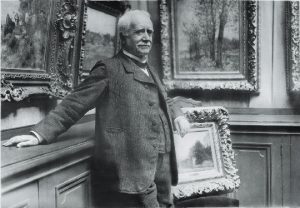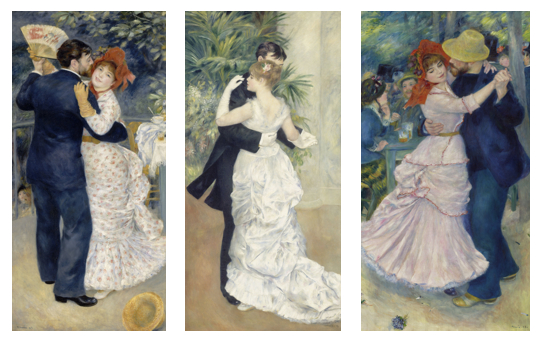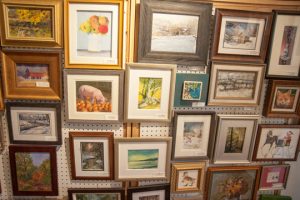Walls covered with paintings are expected in an art gallery, but what does the home of an art dealer look like? In the case of Paul Durand-Ruel, his home looked like an art gallery as well. In fact, he had 270 paintings in his home in Paris and opened his home to the public at the end of the nineteenth century to display his own art collection.

Although the name Paul Durand-Ruel is not as well known as Renoir, Degas and Manet, art critics agree that those artists’ names might not be well known today if Durand-Ruel hadn’t invested those artists who eventually became known as Impressionists. Durand-Ruel continued to support artists by buying their work in bulk often to the brink of personal bankruptcy.
Shown above are three paintings by Renoir of dancers that were pledged to Madame Hiltbrunner as security against financial loan. When the loan was repaid, the paintings were returned. “Dance in the Country” and “Dance in the City” were hung in Durand-Ruel’s home. “Dance at Bougival” was returned to the gallery and eventually sold to a collector.
All three floor-to-ceiling paintings are reunited on one wall of the new exhibit “Discovering the Impressionists: Paul Durand-Ruel and the New Painting” which opens June 24 at the Philadelphia Museum of Art. .
Timothy Rub, Director and CEO of Philadelphia Museum of Art, describes the exhibit as a “fascinating story of an enterprising art dealer who made an early and daring investment in these young artists, and essentially created the modern art market in the face of bankruptcy and public ridicule.”
The scale of art acquisitions was unprecedented. Durand-Ruel purchased 26 paintings by Manet at one time. One wall of the exhibit shows four of the Manet paintings as a tribute to that early and dramatic commitment to the artist.

The exhibit also shows paintings from two of the five solo exhibits, a concept which Durand-Ruel pioneered. The public reception went from tepid to sold out between the 1883 and the 1892 Monet exhibits. Six of the 15 Monet paintings of Poplars from 1892 Monet exhibit are reassembled in Gallery 6.
Monet said “Without Durand, we would have died of hunger, all us Impressionists.” Durand-Ruel purchased around 12,000 pictures over a period of forty years.
The exhibit was five years in the making, a collaboration between the Philadelphia Museum of Art, The National Gallery, London and the Musée d’Orsay, Paris. This is the third and final stop of the exhibit and the only showing in the United States. The exhibit pulls together artwork that once was hung on the walls of Durand-Ruel’s studio and home.

Nine galleries showcase different aspects of Durand-Ruel’s carreer. The introduction includes a commissioned portrait by Renoir of Durand-Ruel. From his family beginning when he took over his family’s art gallery and his discovery of the artists that would become known as Impressionists.
After the successful results from his exhibits in Paris, Durand-Ruel went on to establish markets in the United States and Germany. Mary Cassatt was a Philadelphia artist whose brother became a client to Durand-Ruel's gallery and word spread. Impressionists’ artwork became well received by collectors in the United States by 1886 so that Durand-Ruel opened a gallery in New York. This new audience proved to be the beginning of financial security for the artists.
Although much of the Alfred Barnes collection came through the Durand-Ruel gallery, the time frame was after the period of this exhibit and Durand-Ruel's active involvement. Durand-Ruel's son ran the New York gallery until his death. The Galerie Durand-Ruel no longer buys and sells art but exists as an archive run by Durand-Ruel's decendants. Durand-Ruel’s grandson, Paul-Louis Durand-Ruel, was on hand for the preview.

The exhibit ends with work from Durand-Ruel’s home on the rue de Rome in Paris where he lived with his five children amongst some of the finest impressionists painting ever made.
In conjunction with the exhibition, a film “Exhibition on Screen: The impressionists and the Man Who Made Them” will be shown in over 300 movie theaters across the United States at 7:00 pm on July 14.
NBC Channel 10 in Philadelphia is producing a ½ hour special that will air on July 7, at 7:00 p.m.
The exhibit runs through Sept. 13. Museum hours are Tuesday through Sunday: 10 a.m.–5 p.m., Wednesday and Friday until 8:45 p.m. Tickets are available by calling 215-235-7469 or online at philamuseum.org.
About Emily Myers
Emily Myers has lived and worked in Chadds Ford for over thirty five years. She founded the parent company of Chadds Ford Live, Decision Design Research, Inc., in 1982. ChaddsFordLive.com represents the confluence of Myers' long time, deep involvement in technology and community. Myers was a founding member of the Chadds Ford Business Association and currently serves on its board of directors. Her hobbies include bridge, golf, photography and Tai Chi. She lives with her husband, Jim Lebedda, in Chadds Ford Township.
- Web |
- More Posts(96)




Comments